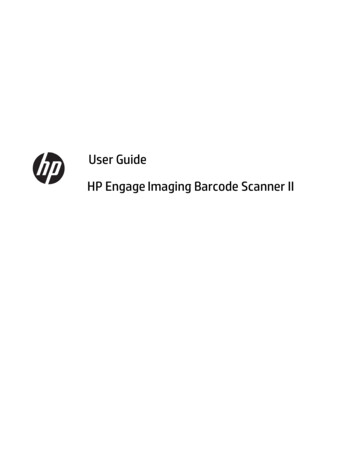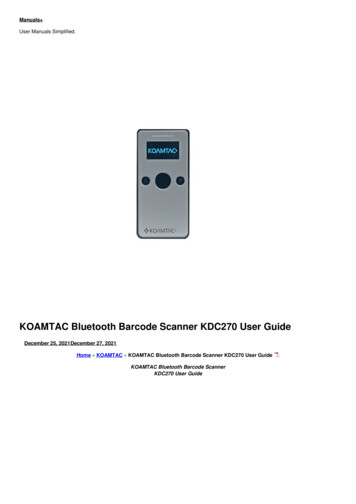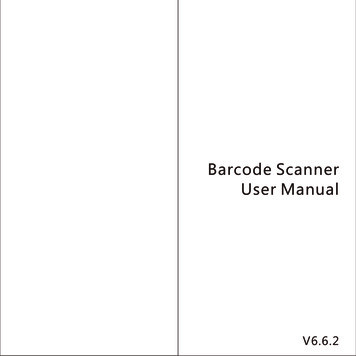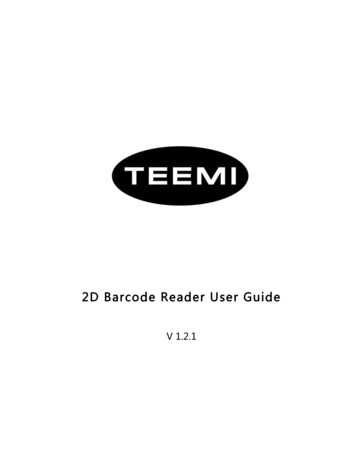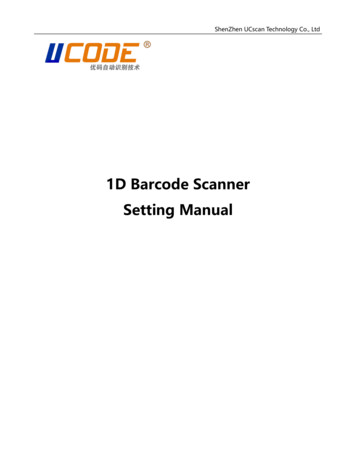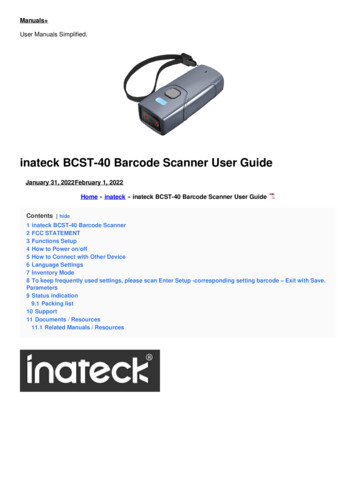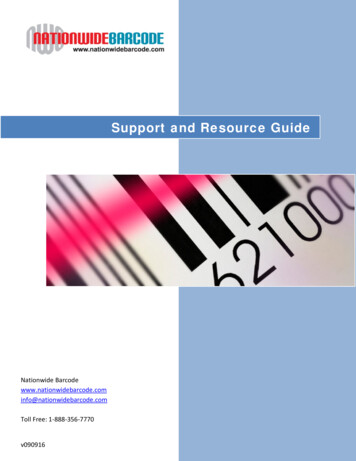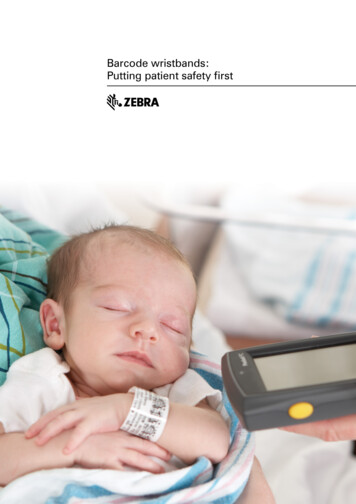
Transcription
Barcode wristbands:Putting patient safety first1
WHAT YOU REALLY NEED TO KNOWABOUT BARCODE WRISTBANDSNearly a quarter of EU citizens have been directly affected by medical error1.In healthcare facilities throughout Europe, illegible, incorrect or missing wristbands areresponsible for the majority of adverse incidents involving medication administration.In contrast to conventional, low quality,handwritten wristbands, modern barcodewristbands help: Accurately identify the patient Provide an environment your patients and theirfamilies can trust Correctly identify and record patient details Ensure the patient record follows themwherever they are, always available to your staffat the point of care Provide your patients with a ‘virtual voice’in their care from start to finish, even whenconversation is not possibleWith budgets and staffing levels pressurised, andlegislative demands constantly evolving, you need toknow that the decisions you make on behalf of yourbusiness are ultimately in the best interests of yourpatients and their well-being.Studies throughout the EUhave shown that up to 10% ofall patients staying in hospitalexperience adverse events.Rushed or illegible notes, missingwristbands, human error, allcontribute to unnecessary,potentially fatal incidents. InEngland, NHS estimates havesuggested that preventable harmfrom medicines could cost morethan 750 million a year2. In theUS, medical errors claim as manyas 98,000 lives each year, and arethe 8th leading cause of death3.Where patient care and safety are concerned,compromise isn’t an option. In order to provide thehighest standards of care, you need to make patientdata available, accurate and reliable, so that yourstaff can carry out their roles with confidence.Barcode wristbands have been proven to be themost effective means of ensuring that your patientsreceive the medication they have been prescribedin the appropriate format. The solutions availableare easy to implement and manage, giving accessto patient information on-demand, minimisingdelays and distractions for your staff, as well as thepotential for misidentification.They help your people to fulfil the ‘five rights’ ofmedication administration — right medication,right dose, right time, right patient and right route.Essentially, they make the fundamental process ofidentification as failsafe as it can be, making use ofmodern technology to save time and money, andreducing complexity.From a C-level perspective, barcoding is seen asa forerunner of advanced patient safety initiativesincluding e-prescribing, computerised physicianorder entry and the electronic medical record (EMR).These tools support healthcare organisations incontinually evolving and improving standards ofpatient care worldwide.1 Source: World Health Organization 2013 s2 Source: National Patient Safety Agency 20073 Source: “To Error is Human: Building a Safer Health System,” Institute of Medicine, November 19992
THE BENEFITS OF BARCODE WRISTBANDS For NursesFor nursing staff delivering care at the bedside,accurate identification and knowing that they aretreating the correct patient is key. Time spent onadministrative processes needs to be kept to aminimum, and tools easy to use and reliable.With barcode wristbands, as long as information isentered accurately on admission, you can be surethat your patients will be identified correctly andrelevant information will be presented every time thewristband is scanned.Barcode scanning is vastly more accurate thanany manual means of data recording, with printedidentification having a one in three million chanceof error. It improves patient safety by improvingthe quality of information, and making it moreimmediately accessible to your staff when andwhere they need it. For ITWith electronic health records the ultimate goal,the IT department needs to know that barcodetechnologies are easy to install, use and manage,while automating workflows, widening applicationacross the organisation and increasing patientsafety.Today’s solutions integrate easily with your existingsystems and software, offering functionality,reliability and quality of output. The centraliseddevice management solutions available enable IT todeliver state-of-the-art technology, consistent deviceconfiguration that save time and money, whileimproving efficiencies business-wide. For ManagementImproved data accuracy is the single most commonmotivation for putting a barcode system in place,as this has a direct impact on patient safety. It alsoincreases staff confidence, streamlines processes andreduces costs. In turn, the results improve the patientexperience, which is also a key management target.By transforming data into a digital format, barcodesenable instant conversion from physical actionsinto digital transactions. This conversion of formermanual tasks to electronic processes occurs inreal-time, increasing staff efficiency, so makingmore time available for active patient care, whileenabling management to make decisions based onaccurate, timely data. Information is adaptable for avariety of applications across the business, too, withautomation greatly simplifying collection, processingand tracking.How barcoding worksA barcode is simply an alternative to text forexpressing information. Anything that can normallybe printed on a wristband can be encoded in abarcode that can also act as a key to a database,so making more information more immediatelyavailable to the user.Because barcodes store data in less space thanhandwritten or typed text, standard barcodewristbands can include more information thanconventional ones, two-dimensional barcodesmore still. They can serve as portable recordsor even carry a digital photograph of the patient,viewable on a PC or laptop whenever the barcodeis scanned.With this system in place, staff scan the wristbandto identify the patient using a scanner interfacedto a mobile or bedside computer. The informationis matched with the barcode on the medicationor with blood or specimen samples. Applicationsoftware then compares the medication toinformation in the patient’s electronic record, calledup by the wristband scan, to verify that the patientshould be receiving the medication at the indicateddosage and method at that time.Finally, staff can scan their own barcoded IDbadge to record who administered the medication.The system essentially automates the FiveRights check, with the wristband scan verifyingright patient, and the database search from themedication scan verifying the other elements.3
6 STEPS TO IMPLEMENT BARCODE TECHNOLOGY134Ideally, a wristband willinclude two forms of patientidentification. Encoding thepatient’s name in a barcode andprinting an ID number in humanreadable text will satisfy statutoryobligations. Any type of text canbe encoded in a linear or twodimensional barcode.Maximising Quality:Healthcare quality requirementsand environments demandexcellent barcode symbol quality.Scanners decode the informationfrom barcodes by measuring thedifferences between narrow andwide elements, and the contrastbetween dark bars and lightspaces. If the ratios or contrastare slightly off, the barcode couldbe difficult or impossible to read.Barcode type – what type ofbarcode needs to be read?Printing the rightinformation2Choosing the correctbarcode typeThere are many different typesof barcodes, called symbologies.These vary by a number of factorsincluding the amount and typeof data they can encode, and thespace they require to do this.Two-dimensional barcodes act aslimited portable record files andprovide commonly needed patientinformation including allergies,primary physician, blood type,and reason for admission.By using wristbands thatincorporate GS1 barcodes,you meet the most commonglobal standard for automaticidentification and data capturefor patient identification.Selectinga printerFor best results, choose printersthat produce crisp, clear printquality on all wristbands, sobarcodes scan quickly andreliably. A nurse’s time is toovaluable to waste by repeatedlytrying to read poor-qualitybarcodes, or by rushed, manualdata entry.Leveraging an existing laserprinter:If your staff already have accessto high-quality laser printers,there’s not necessarily the needto invest in new printer hardware.A dedicated tray of the existinglaser printer can be used forbarcode print media materials.The benefits of thermal printers:Thermal printers use controlledheat to create an image on thewristband. The print head appliesheat to the coated thermal media,which turns dark where the heatis applied. There is no ink ortoner required – the only supplyneeded for direct thermal printersis the wristband material itself.Printing wristband and labels ondemand saves time and enablesyour people to produce durableand high-quality wristbandsconveniently and cost-effectivelyat the point of care.Selecting aBarcode ScannerWhilst both laser scanners andlinear imager scanners readstandard linear (1D) barcodes,only 2D Area Imagers operateacross a wider spectrum ofbarcodes - 1D, stacked, and2D. Not only are 2D imagersmore “intelligent”, their abilityto analyse an image from anydirection and off any surface(including screens), makethem faster and easier to use –resulting in real time savings foroperators.Form Factor – what designof scanner will best meetyour requirement?Handheld – simply aim thescanner at the bar code andpress the button. Easy andintuitive to use.Presentation – these scannersare fixed to a counter top and, asthey scan automatically, provide ahands-free scanning option.Mobile Computer – as the namesuggests, these combine PCfunctionality and a scanner in asingle device. These hand-helddevices offer complete mobility,providing storing and analysis ofinformation on the move.Connectivity – cordedor cordless?Using Bluetooth technologyallows most cordless scannersto operate wirelessly within arange of over 30 ft from theirbase stations. However, if all yourscanning requirements can bemet from a central point, a cordedscanner may be preferred.Healthcare compliant?Finally, within a healthcareenvironment you will need toensure that any scanner youbuy can withstand cleaningwith disinfectant.4
6 STEPS TO IMPLEMENT BARCODE TECHNOLOGY5Selecting the bestlabel materialSelection of the label materialdepends first on whether directthermal or thermal transfer printtechnology is being used. Foroptimum printer performance andto extend the life of the printhead,it is important to choose the rightmedia, including ribbon in thecase of thermal transfer printing.6Understandingbest practiceRepeating a two-dimensionalbarcode along the entire length ofthe wristband makes it easier fornurses to scan. Beyond the actualbarcode, it helps to print withhuman-readable text the patient’sor the infant’s and/or mother’slast name and first name on theband so that clinicians can easilyread it, and for compliance.The software that encodesdata for healthcare wristbandssupports standard defaultsincluding the patient’s date ofbirth, age and sex. Specifying thatwristbands are always issued withthe same information, includingpatient number, first and lastname, and date of birth in bothbarcoded and human-readableform, has the added benefit ofensuring the same data is alwaysprovided and in the same locationfor fast and efficient identification.This helps to streamline theoverall patient identification andrecord-keeping process.To improve security, add aprint time, date and user namein human-readable text. Thisreduces security concerns withcopying the barcode or patientinformation, or putting the bandson other patients.5
SUMMARYThe definitive patient identification solutionZebra’s portfolio of Healthcare solutions extend fromprinters to scanners, wireless networks to mobilecomputing. Enhancing patient safety, improvingoperational efficiency and optimizing IT resources, theirproduct range covers multiple applications, includingmedical administration, specimen collection, patientID and personnel, remote patient monitoring, logistics,and laboratory/pharmacy management.To find out more about ourbarcode printing solutions,visit www.zebra.comCorporate Headquarters 1 800 423 0442inquiry4@zebra.comAsia-Pacific Headquarters 65 6858 0722apacchannelmarketing@zebra.comEMEA Headquarters 44 (0)1628 556000mseurope@zebra.comLatin America Headquarters 1 847 955 2283inquiry4@zebra.comOther Locations / USA: California, Georgia, Illinois, Rhode Island, Texas, Wisconsin Europe: France, Germany, Italy, the Netherlands, Poland, Spain, Sweden,Turkey, United Kingdom Asia Pacific: Australia, China, Hong Kong, India, Indonesia, Japan, Malaysia, Philippines, Singapore, South Korea, Taiwan, Thailand, VietnamLatin America: Argentina, Brazil, Colombia, Florida (LA Headquarters in USA), Mexico Africa/Middle East: Dubai, South Africa 2016 ZIH Corp. All product names and numbers are Zebra trademarks, and Zebra, the Zebra head graphic and ZPL are registered trademarks of ZIH Corp.All rights reserved. Bluetooth is a registered trademark of Bluetooth SIG, Inc. Apple, iPad, iPhone and iPod touch are trademarks of Apple Inc., registered inthe U.S. and other countries. All other trademarks are the property of their respective owners.
patient's name in a barcode and printing an ID number in human-readable text will satisfy statutory obligations. Any type of text can be encoded in a linear or two-dimensional barcode. 2 Choosing the correct barcode type There are many different types of barcodes, called symbologies. These vary by a number of factors including the amount and type

